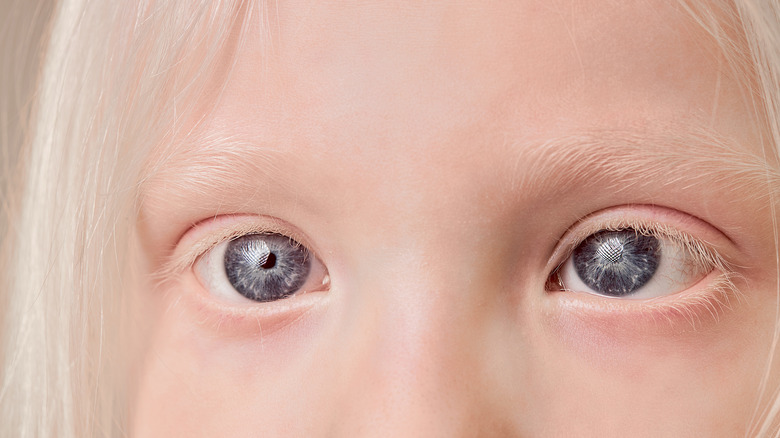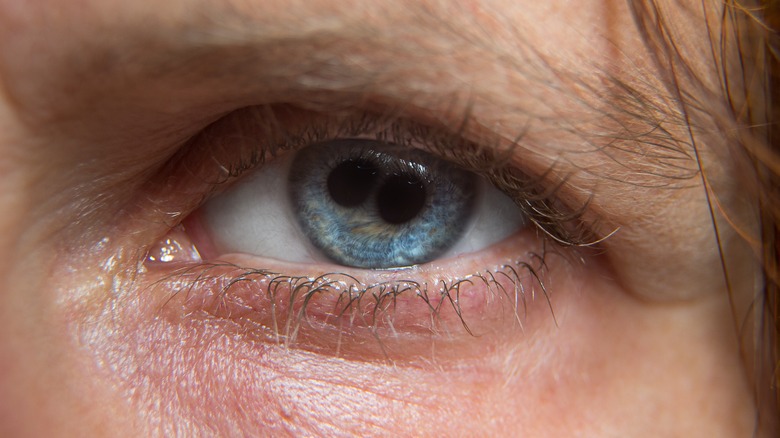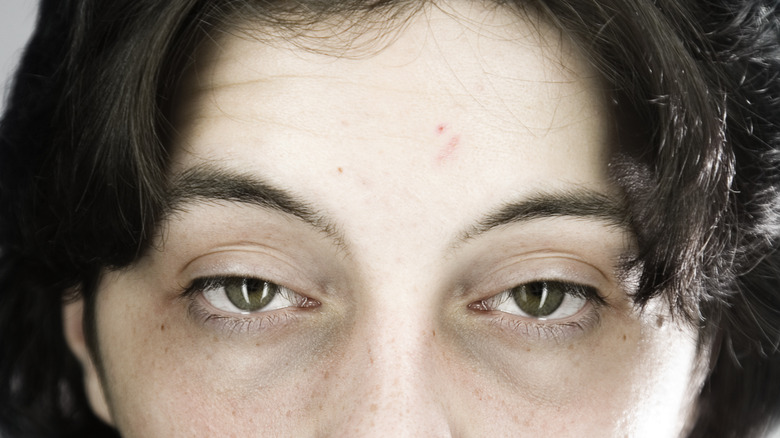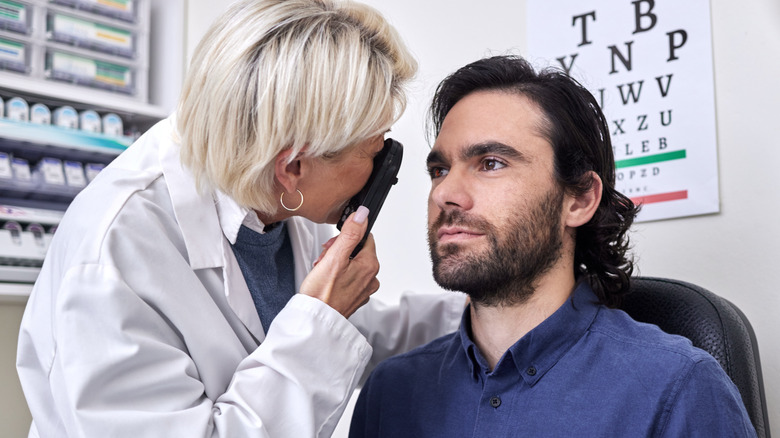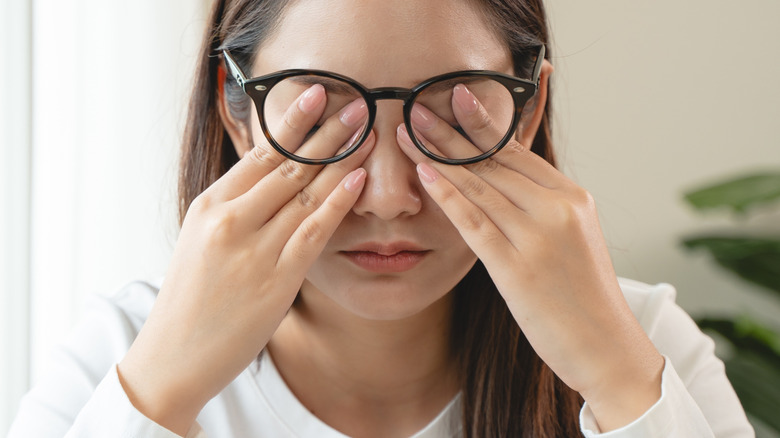Rare Eye Features Many People Don't Have
Some people have unique eyes that make them stand out in any crowd. They may have beautiful, almond-shaped eyes that highlight their cheekbones. Or perhaps their eyes may appear larger than most, giving them a bright, youthful vibe. Most of these looks are created with the help of makeup, but there are people who are simply born with rare eye features.
Ophthalmologists see all kinds of eye variations, ranging from unique eye colors to distinct pupils. Some may possess small eyes, while others may have eyes that are wider than normal. Not many people have these amazing features, which is likely why they are particularly noticeable when your favorite stars exhibit uncommon eye qualities. For example, Kate Bosworth has eyes of different colors: one is hazel, while the other is blue. She is definitely not the only person with this condition, though.
Learn more about the different conditions that bring about these instantly noticeable eye features, as well as which well-known celebrities have them.
Heterochromia: one pair, different colors
The eyes are said to be the window to the soul, and tend to be among the first things about a person that catch your attention. In some cases, eyes can have vivid colors and noteworthy variations. For example, some eyes are green, which is reportedly the rarest eye color. Speaking of eye colors, some of your favorite celebrities actually have more than one — and you might not even be aware of that fact.
Heterochromia is a condition where the irises of the eyes are two different colors, according to the American Academy of Ophthalmology. Some people have two eyes that are entirely different colors. For example, Jane Seymore has one brown eye and one green eye. While a full-color change in each eye is a sight to behold, partial heterochromia may also come into play; this means that a person possesses eyes that are mostly the same color, but one of the eyes has a bit of another color mixed in. Henry Cavill has two blue eyes, but one has a bit of brown. You might also see individuals with different colors on their eyes' inner and outer rings (central heterochromia).
Heterochromia is just a color variation and doesn't typically cause any issues with the eye. It can also be present upon birth or acquired later in life due to an injury or disorder, according to WebMD.
Ocular albinism and a lack of pigment in eyes
The pigmentation of your iris doesn't just make for beautiful eye variations; it's also necessary for vision. Your eye needs a certain amount of color in the iris to function normally, so being born without enough color in your eyes can lead to some optical issues.
Ocular albinism is the lack of pigmentation centered in the iris and retina of the eye. Typically caused by a genetic mutation, this eye condition leads to light blue irises and reduced pigmentation in the retina. The lack of pigmentation can cause the eyes to appear violet or red, creating problems with depth perception, sensitivity to light, rapid eye movements, visual acuity, and involuntary eye movements. Treatment typically includes corrective lenses and dark glasses, per the National Organization for Rare Disorders.
Ocular albinism doesn't affect the skin or hair (just the eyes), which makes it distinct from albinism, a condition that causes the whole body to lack pigment (via MedlinePlus). However, those with albinism can have the same visual symptoms due to a lack of melanin within the iris of the eyes. It's typically why many people with albinism have light or even violet-looking eyes and are very sensitive to light.
Polycoria means multiple pupils
According to Healthline, polycoria is a condition where a person has numerous visible pupils within their eyes. When it comes to polycoria, not all eyes are created equal. So, you might find that the person has two pupils in only one eye, or they might have the condition in both eyes. The eye feature can also cause more than two pupils in an eye. Despite the number of pupils, this condition can be either true polycoria or pseudopolycoria, per the Vision Center. The true version features two fully functional pupils, while pseudopolycoria involves a fake pupil that doesn't function independently. The fake pupil is typically a hole in the iris from eye damage or abnormalities.
Having two pupils might not affect your vision. With that said, symptoms may include blurred vision, poor night vision, and oddly-shaped pupils. Since the tissue that divides the pupils can be small or less noticeable, the condition might go undiagnosed until adulthood (via Healthline). Additionally, those experiencing symptoms like blurred vision can try surgery such as a pupilloplasty, where the two pupils are combined. However, most of the time, any visual impairment from having two pupils is minimal and doesn't really require treatment (via Vision Center).
Cat eye syndrome creates a rare pupil shape
Cats have distinctive eyes with elongated pupils. Interestingly, some folks have found this appealing enough to make them want to wear contacts that give them that feline look. People with a rare chromosomal disorder known as cat eye syndrome (CES) are born with pupils that mimic the shape of a cat. The National Organization for Rare Disorders (NORD) notes that the ocular symptoms of CES can vary (meaning not all individuals with it are born with cat-like pupils).
CES patients (such as model Caitin Stickels) have such distinct eyes due to the ocular tissue. Much like a fissure on other areas of your body, the ocular tissue has a fissure on the top and bottom of the eye, creating a uniquely elongated feature. In addition to cat eyes, this disorder can lead to lip, heart, ear, kidney, and skeleton abnormalities. With that said, the unique shape of the pupil is only one eye symptom of CES; other signs include having crossed eyes and the absence of an iris. Treatment of the disorder depends on the different symptoms that a person might experience, and may include surgery.
Coloboma: a distinctive keyhole pupil
Actor John Ritter had a condition known as coloboma, which caused a unique shape in his right pupil. The missing tissue near the pupil creates a keyhole shape that can quickly get mistaken for heterochromia. This condition can also create a cat's eye shape, but only affects the eyes.
According to the American Academy of Ophthalmology, coloboma develops in the womb and can result in several missing eye parts. For example, eyelid coloboma is when part of the eyelid is missing; meanwhile, lens coloboma means that part of the lens is missing. A partially missing iris is called uveal coloboma, and comes with symptoms like double vision, light sensitivity, low vision, and blurry vision. The Cleveland Clinic also notes that 1 out of 10,000 babies has this condition, making it rare.
Given its genetic nature, coloboma can affect one or both eyes. Any resulting vision issues can be corrected with contacts or glasses. Some individuals might not experience symptoms at all, but use contacts to help to regulate the size of their pupils.
Anisocoria means different-sized pupils
Iconic musician David Bowie had anisocoria, a condition in which his pupils were naturally different sizes. While the pupil in his right eye contracted and expanded, the left eye was permanently large, making one eye look more bluish than the other.
Anisocoria is typically seen by most healthcare professionals as a symptom of an underlying condition, especially if the patient wasn't born with uneven-sized pupils. According to the Cleveland Clinic, uneven pupils may point to a stroke or an aneurysm. It can also result from an injury, like in Bowie's case (via The Cut). However, some people are just born with uneven pupils due to heredity. The difference might be so minute that you won't realize even the pupils are different sizes; however, it could still cause eye pain and light sensitivity. Depending on what caused the condition, the uneven pupil look could be acute or chronic.
Given several conditions that can cause anisocoria, it's essential to see a healthcare professional if you suddenly notice your pupils are different sizes. Prompt diagnosis is essential to get the right treatment.
Microphthalmia leads to small eyes
Some rare eye features can lead to devastating sight loss. British voice actress and model Anna Cannings was born with a condition known as microphthalmia, meaning her eyes are smaller than average. This condition typically results in blindness or vision loss for 1 in 5,200 people born with it, according to the Centers for Disease Control and Prevention. This can affect one or both eyes, and it's commonly associated with anophthalmia (when one or both eyes are missing at birth).
This genetic disorder causes abnormally small eye sockets, leading to the eyeballs becoming misshapen (via the National Eye Institute). Individuals with this microphthalmia may also experience coloboma and cataracts. While the cause is primarily unknown, genetics and environmental factors could be to blame. When the condition is noticed early in life, there are treatments and methods (such as surgery) to help expand the eye socket. However, vision is typically affected due to the way the eye socket changes the eye in vitro.
Smaller-than-average eyes can lead to many complications regarding your vision. Research on this condition and its possible causes is still ongoing.
Chronic progressive external ophthalmoplegia
You might have known someone born with a drooping eyelid and had surgery to correct it. A droopy eyelid is just one symptom of a condition known as chronic progressive external ophthalmoplegia (CPEO), but it's not present when you're born. It doesn't start to affect the muscles of your eyes until you're typically in young adulthood; however, it can begin earlier or later, depending on the person.
CPEO is a bit of a stealthy disease caused by DNA mutations as you age, according to Science Direct. You might start to show symptoms early, but they can be inconsistent. Your eyeball can also be affected, making eye movements more difficult. So, you might notice that it's harder than usual to keep your eyes open or that you're having issues with your vision that typically cause you to consult your eye doctor. In addition to affecting one or both eyes, this mitochondrial disease can also weaken the muscles in your body (via the American Academy of Ophthalmology). That's why some people with CPEO might have difficulty swallowing or heart problems.
Treatment options (e.g., surgical interventions) are available for CPEO to help with the symptoms, but there is currently no cure for it. Medications are also available to help with the general weakness that patients with CPEO feel.
The vibrant eyes of Waardenburg syndrome
Some eye colors grab your attention, and refuse to let go. Paris Jackson has eyes that are a clear, icy blue that's reminiscent of an ancient wolf. The inner ring is sky blue, while the outer ring is a deep aqua. While the model's eyes are undoubtedly beautiful, could it be more than just luck that's at play here? In an interview with Teen Vogue, celebrity makeup artist Jo Baker shared that Jackson has "a rare eye condition that affects the coloring of her eyes" — and the signs point to it being Waardenburg syndrome.
Waardenburg syndrome is a genetic mutation that causes distinct coloring in the hair, skin, and eyes, according to MedlinePlus. The syndrome might present as very pale eyes or cause heterochromia. Additionally, those with Waardenburg syndrome can have white patches in their hair or turn prematurely gray. Depending on the variation you carry, other symptoms include hand abnormalities and hearing loss, which is present at birth. Skin, hair, and eyes are affected due to the effect the gene mutation has on melanin (a substance that causes pigmentation). It can also cause distinct features of the face like wider eyes (via the National Organization for Rare Disorders).
What is a free-floating iris cyst?
Have you ever seen a ball of color moving around in someone's eye? Rather than just having a brown spot on the top of the eye or a little green in the outer ring, a free-floating cyst is a colorful glob that swims around your iris.
This unique eye feature is a bit of a rarity, and scientists aren't entirely sure why it happens. But you can be born with it, or it can be the result of an eye injury. Additionally, you can have more than one free-floating cyst. A 2016 Ocular Oncology and Pathology case study noted a patient with multiple cysts floating within the eye. These rare eye anomalies might go unnoticed for the most part because they can be present without any pain or irritation. However, they can cause secondary glaucoma if they start to grow or change. They might also create black spots when they move around in the field of vision.
Surgical treatments are available to drain and remove the cysts if they cause issues or affect the field of vision. However, if it doesn't affect your vision, most healthcare specialists are likely to just leave it alone.
Graves' ophthalmopathy causes eyes to bulge
Graves' disease is an immune system disorder that causes your body to overproduce thyroid hormones, leading to a wide range of both emotional and physical symptoms.
According to the Mayo Clinic, about 30% of patients with Graves' disease also have Graves' ophthalmopathy, an ocular condition that causes various symptoms like gritty eyes, puffy eyelids, and light sensitivity. The most noticeable symptom is bulging eyes, which are caused by your body attacking the tissue around the eye. Singer Missy Elliott has been living with the condition since she was diagnosed in 2008 (via People).
While there is currently no cure for Graves' ophthalmopathy — as Elliott told the magazine, "You live with it for the rest of your life" — medications, diet, and exercise can help control its symptoms. Ultimately, if you notice a sudden change in the shape or color of your eyes, check with your healthcare professional as soon as possible.
Charles Bonnet Syndrome
When a person loses their vision — either partially or completely — they may start to develop hallucinations that fill the gaps. This is known as Charles Bonnet Syndrome (CBS). There's a misconception that the condition occurs as a result of mental health concerns, but it's actually strictly related to vision loss resulting from conditions like cataracts, glaucoma, and age-related macular degeneration.
While it typically affects people over the age of 80, anyone can develop the syndrome. It's estimated that anywhere from 10% to 30% of individuals who've lost vision in both eyes may have Charles Bonnet Syndrome. "When people meet with vision loss due to a disease like glaucoma, age-related macular degeneration, or diabetic retinopathy, their visual system does not process new images. In the absence of visual data that's being transmitted through your eyes, the brain fills the void and compensates for images or recalls stored images for you to see," explains ophthalmologist Dr. Nikhil Seth to the Hindustan Times.
The hallucinations can vary, from moving people and animals to geometric shapes and landscapes. They can be in color or black and white, and they can be based on actual figures or imaginary ones (like mythical characters). There's no real rhyme or reason to the hallucinations, as they can last for just a few seconds or for as long as a few hours. The only way a professional can diagnose Charles Bonnet Syndrome is by omitting possible other causes, like dementia or other neurological health concerns.
Limbal dermoid
The limbal dermoid is fairly rare — rare enough that eye doctors aren't likely to see it more than once or twice during their entire career, says ophthalmologist Dr. Mark Fromer of Lenox Hill Hospital. This benign cyst can grow on the eyeball and consists of tissue that typically occurs elsewhere in the body, including hair follicles, sweat glands, and cartilage. The former is the most common of the symptoms, lending the tumor the moniker "hairy eyeball."
The growth is typically a white or pale yellow color and may have visible sprouts of hair. While there isn't an exact known cause of limbal dermoids, they can sometimes develop in people who have other rare conditions like encephalocraniocutaneous lipomatosis (which causes abnormalities of the skin on the head and the face, as well as the eyes and brain) and Goldenhar syndrome (which causes impaired development of the facial bones).
Limbal dermoids can sometimes lead to blurry vision, but won't typically lead to blindness because they aren't located directly on the central cornea. They're most commonly found on the white of the eye. Some people may even elect to leave their limbal dermoid as it is, provided it doesn't cause discomfort, show any signs of growth, or cause significant changes to vision. However, it can be surgically removed in cases when it causes distress, either physically or cosmetically.
Strabismus
People whose eyes are misaligned have strabismus. This means that the eyes point in different directions; while one eye looks straight ahead, for example, the other may be turned to the side or upward. While this condition typically affects children, it's possible to develop adult strabismus, too. When that happens, it's often as a result of another medical ailment, like a stroke or some type of trauma to the eye. Even adults who had the condition as a child may experience a recurrence if it wasn't properly treated. "Unfortunately, as we age, our eye muscles do not function as well as they did in the past. We call that decompensation," explains surgeon Dr. Martha Howard of Yale Medicine.
Strabismus can be classified by the direction the misaligned eye turns. Eyes that point upward have hypertropia, while those looking downward have hypotropia. When the eye looks inward, it's known as esotropia. An outward-pointing eye is called exotropia. Some people's strabismus symptoms are always present, and are therefore classified as constant. Others have intermittent symptoms that may develop when they're stressed or when their eyes are strained.
Because the eyes don't focus in a single direction, the brain essentially receives two messages. That, in turn, leads to blurry vision. Very occasionally, according to Dr. Howard, "[t]he double vision will resolve with time." Others, however, may require surgical intervention when vision problems grow severe.
Aniridia
Aniridia, or "no iris," is a genetic disorder that affects both eyes. It is fairly rare, affecting some 1 in 50,000 to 100,000 people (per the American Association for Pediatric Ophthalmology and Strabismus). Those who have aniridia have pupils that appear especially large. Because the iris plays such a vital role in controlling how much light enters the pupil, aniridia can cause significant visual distress and lead to symptoms like sensitivity and harsh glare. Eventually aniridia can lead to other eye health concerns, including glaucoma, cataracts, and retinal detachment.
People are born with aniridia, as it develops in the womb between the 12th and 14th weeks of pregnancy. The condition occurs most often due to a mutation in the PAX6 gene, but can also develop when adjacent genes have abnormalities. The affected gene is vital to the proper formation of the eyes, spinal cord, brain, and pancreas. It's not a given that the children of people with aniridia will also inherit the condition, but the odds do increase.
The condition is treated by addressing vision concerns. Common treatment options include glasses and contact lenses. Colored contact lenses may be useful in creating an iris-like shape that protects the pupils from excess light exposure. If other eye conditions like glaucoma or cataracts develop as a result of aniridia, surgical measures may be necessary.



